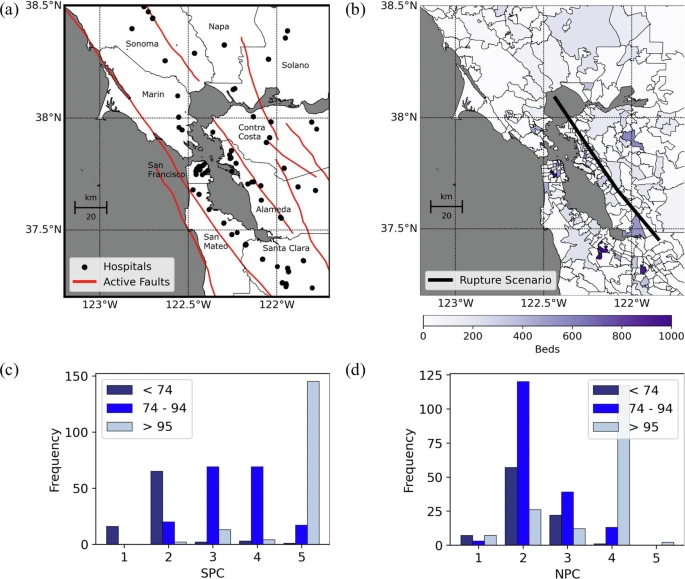How a Major Bay Area Earthquake Could Disrupt Essential Health Care Access

A new study offers a stark look at how a major earthquake in the San Francisco Bay Area could severely disrupt access to emergency medical care. The research, conducted by experts from UC Berkeley, New York University, Stanford University, and the World Bank Group, models the impact of a magnitude 7.25 earthquake on the Hayward Fault—one of the most dangerous and overdue faults in California. What they found is both eye-opening and deeply concerning, especially for residents who rely on already-strained hospital systems.
The Bay Area has long known that a large earthquake is inevitable. What hasn’t been fully understood until now is how quickly and how drastically hospital access could collapse when both medical buildings and the transportation networks feeding them are hit simultaneously. This study approaches the issue on a regional scale, using real-world data on 76 hospitals, 426 hospital buildings, 16,639 beds, and an enormous network of 5,163 bridges. The goal was simple: map out what actually happens when hospitals and roads fail together in a highly populated region.
The results are a sobering reminder that natural disasters don’t just damage structures—they create cascading failures that can restrict access to lifesaving care at the exact moment it’s needed the most.
The Hayward Fault Scenario Explained
The model simulates a M7.25 earthquake on the Hayward Fault, which runs directly beneath densely populated cities in the East Bay. This is not a hypothetical worst-case scenario—this fault has been building tension since its last major rupture in 1868, making it overdue for large movement.
Because a massive portion of the Bay Area’s health care infrastructure sits close to active faults, the researchers wanted to understand how many hospital buildings might be damaged, nonfunctional, or completely inaccessible due to surrounding road and bridge failures.
To do this, they used structural data such as each building’s age, construction type, seismic performance category, and nonstructural safety levels. For example, 19% of the hospital buildings in the dataset were built before 1973, the year California introduced its first major hospital seismic safety law. Older facilities are far more likely to sustain heavy damage.
This kind of detailed, infrastructure-focused modeling goes well beyond earlier studies, which often looked at a single hospital or a small local area. Here, the entire region is analyzed as one interconnected system.
How Much Hospital Capacity Would Be Lost?
One of the most alarming findings is the projected loss of hospital bed capacity:
- Across the region, capacity could drop to 51% of normal levels.
- Alameda County is hit the hardest, retaining only 20% of its beds—roughly 651 functional beds out of 3,221.
When you consider that Alameda County alone has 1.6 million residents, the remaining bed count is far from sufficient for post-disaster emergency needs.
But the crisis doesn’t stop with damaged hospitals. Even hospitals that remain functional may be overwhelmed by patients redirected from nearby failed facilities. The loss of nearby capacity creates ripple effects, pushing more people to travel longer distances—if they can travel at all.
Transportation Failures Make Everything Worse
A major earthquake doesn’t just damage buildings; it also devastates the transportation network. Thousands of bridges in the Bay Area sit close to fault lines, and in this simulation many of them failed.
Key findings include:
- Regional travel times to hospitals increase by 177%, jumping from 6.1 minutes to 16.9 minutes on average.
- In some areas of the East Bay, travel delays skyrocket to over 1000%.
- In Alameda County, only 282 bridges out of 642 remain functional—about 44%.
This means even if a hospital survives structurally, it may be completely isolated from the people who need it or cut off from essential supplies and emergency personnel.
The study gives a powerful example:
In Novato (Marin County), average travel time to the nearest hospital jumps from 7.3 minutes to 185.5 minutes when both hospital and transportation failures are considered together. If only hospital failures are considered—but roads remain intact—the delay would be just 14.1 minutes.
This clearly shows the “double impact” caused by simultaneous infrastructure failures.
Why Infrastructure Interdependence Matters
One of the biggest insights from the study is that health care systems cannot be analyzed separately from transportation systems. When a hospital fails, or when a bridge collapses, the effects spread far beyond that point.
Interdependent failures can create:
- Overcrowded hospitals
- Isolated communities
- Extremely long travel times
- Reduced emergency response capability
- Increased fatality rates due to delayed care
This study provides one of the most thorough simulations ever created for analyzing how regional health care access breaks down during a major seismic event.
It also emphasizes an important message: focusing on a single hospital or a handful of bridges will never be enough. The entire system must be strengthened in a coordinated way.
Broader Context About Hospital Safety and Seismic Readiness
California has long been a leader in hospital seismic safety. Several major regulations aim to ensure that hospitals can operate after major earthquakes. For example, by 2030, many hospitals must meet strict standards for both structural and nonstructural performance.
Still, many challenges remain:
- Many hospitals built before the 1970s require costly retrofitting.
- Nonstructural systems—like generators, water systems, and medical equipment anchoring—can fail even when the building survives.
- Some facilities simply do not have the space or funding for major upgrades.
- Transportation networks often lag behind hospitals in terms of seismic reinforcement.
Past earthquakes like the 1971 San Fernando and 1994 Northridge events have shown how severely earthquakes can disrupt hospital operations, forcing evacuations even when buildings look intact from the outside.
This new research underscores how much work is still needed to prepare for the next major Bay Area quake.
What This Means for Bay Area Residents
The key takeaway is clear: if the Hayward Fault ruptures in a major earthquake, the entire region will face a sudden and severe drop in medical access, not just because hospitals are damaged, but because the surrounding roads and bridges will make it extraordinarily difficult to reach functioning facilities.
This isn’t meant to scare people—it’s meant to guide better planning. The study highlights exactly where investments should be focused:
- Strengthening hospitals and retrofitting older medical buildings
- Reinforcing bridges and key transportation links
- Planning for alternate routes and emergency traffic management
- Ensuring hospitals have backups for power, water, and critical systems
- Preparing mobile medical units or field hospitals for rapid deployment
In short, resilience planning needs to consider the entire system, not just isolated parts. This research offers a detailed roadmap for doing exactly that.
Research Paper
Accessing acute care hospitals in the San Francisco Bay Area after a major Hayward earthquake (Nature Communications, 2025)
https://www.nature.com/articles/s41467-025-64354-6





